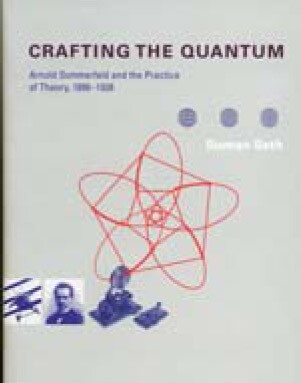Crafting the Quantum: Arnold Sommerfeld and the Practice of Theory, 1890-1926
DOI: 10.1063/1.3490503
Arnold Sommerfeld (1868-1951) was appointed to the chair for theoretical physics at the University of Munich in 1906; he was recommended by his colleague Wilhelm Röntgen to fill that post, which had been vacant since Ludwig Boltzmann moved back to his native Vienna in 1893. In the first quarter of the 20th century, Sommerfeld corresponded with the leading physicists of the day, including Max Planck, Woldemar Voigt, and Albert Einstein. He also corresponded with the younger contemporary mathematical physicists, as theoretical physicists were then usually called, including Max Born, Niels Bohr, and Erwin Schrödinger.

In writing Crafting the Quantum: Arnold Sommerfeld and the Practice of Theory, 1890-1926, Suman Seth has mined those correspondences extensively. A historian of 19th- and 20th-century physical science at Cornell University, Seth traces Sommerfeld’s roots in applied mathematics, which led to his rise in theoretical physics. After completing his dissertation under mathematician Ferdinand von Lindemann at Albertina University in Königsberg, East Prussia, Sommerfeld carried out his postdoctoral work as a member of the entourage of mathematicians David Hilbert and Felix Klein at the University of Göttingen; he collaborated with Klein on the four-volume, 966-page applied-mechanics treatise Über die Theorie des Kreisels (On the Theory of the Gyroscope).
Sommerfeld’s other early publications were on hydrodynamics and the theory of lubrication, wireless telegraphy, and oscillations in coupled AC circuits; one paper was entitled “Zur Theorie der Eisenbahnbremsen” (“On the Theory of Brakes on Railroad Cars”). He also taught applied mathematics to engineers at postsecondary technical institutions in western Germany before he was called to chair the Munich theoretical physics department. Too old to be drafted during World War I, Sommerfeld worked on problems of radio telegraphy and ballistics for the Kaiser Wilhelm Foundation for War Technology and Science (which disappeared after World War I). Indeed, the path of Sommerfeld’s career showcases the close link between pure and applied physics.
Seth argues that advances in theoretical physics are characterized by two contrasting approaches: applying general laws and principles to physical phenomena, as Einstein did with relativity and Planck did with thermodynamics, and using experiments, models, and hypothetical mechanisms to infer general rules, as Sommerfeld did in developing atomic theory.
Sommerfeld is best known for his 1916 relativistic generalization of Bohr’s model of the atom, his introduction of the fine-structure constant, and his analysis of the effects of electric and magnetic fields on atomic spectra. He is also known for writing some of the first atomic- and quantum-physics textbooks. Atombau und Spektrallinien (Atomic Structure and Spectral Lines), Sommerfeld’s problem-oriented treatise on the old quantum theory, first published in 1919, was revised almost annually until 1924. He published his last text on quantum physics, Wellen-mechanischer Ergänzungsband (Wave Mechanical Supplement), in 1929, after the emergence of Schrödinger’s wave mechanics; Paul Dirac’s aptly named The Principles of Quantum Mechanics followed in 1930. Sommerfeld’s multivolume Lectures on Theoretical Physics featured a number of technical applications. In the 1940s I studied his excellent textbooks on classical mechanics and electromagnetic theory.
A significant portion of Crafting the Quantum is devoted to a discussion of what is now known as the Sommerfeld school of theoretical physics. Nearly one-third of all full professors of theoretical physics at German-speaking European universities in 1928 were former doctoral students of Sommerfeld, who was the “doctoral father” to four Nobel Prize winners: Werner Heisenberg, Wolfgang Pauli, Peter Debye, and Hans Bethe. Many American physicists, including Linus Pauling, I. I. Rabi, and Edward Condon, went to work with him. (In recognition of his impact on the teaching of physics, the American Association of Physics Teachers awarded Sommerfeld its Oersted Medal in 1949.)
Crafting the Quantum can be approached on two different levels: For the historian, it is a monograph on the practice of early-20th-century theoretical physics and a commentary on Thomas Kuhn’s much-debated views on the way science advances; for the general reader, it is an account of the transition from the old “quantum-number mystique” to modern quantum mechanics based on general symmetry principles and invariance. From the latter vantage point, the book should be of interest to anyone who has studied quantum mechanics.
More about the Authors
Eugen Merzbacher. Chapel Hill, North Carolina, US .




